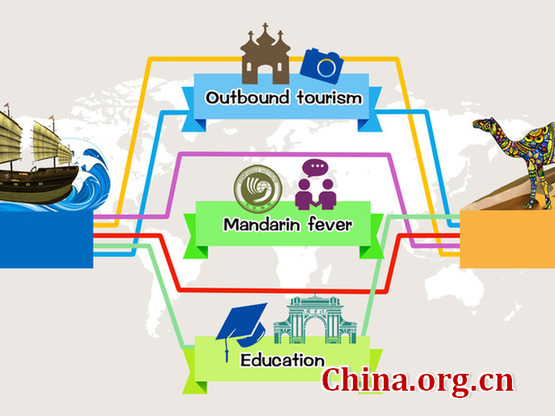Maritime synergy under the Belt and Road
- By Sabena Siddiqui
 0 Comment(s)
0 Comment(s) Print
Print E-mail China.org.cn, June 28, 2017
E-mail China.org.cn, June 28, 2017
|
|
|
B&R Initiative promotes connectivity [Cartoon by Zhai Haijun] |
In a bid to enhance maritime connectivity and regional integration, China has shared a plan for three ocean corridors or "blue economic passages." Recently released by China's top planning bodies, the National Development and Reform Commission and the State Oceanic Administration, it is a joint ocean governance strategy for all the countries situated along the 21st Century Maritime Silk Road.
Synchronizing development and promoting joint actions, the document enumerates an all-dimensional Blue Partnership enacted on various levels with a broad, open scope.
Visualizing a "blue economy," maritime cooperation will help Belt and Road nations face challenges together to enhance regional stability. Creating a "blue engine" and inclusive platforms to bridge differences with consensus would result in a broader participation of governments and international organizations.
According to Wang Hong, head of the State Oceanic Administration, it is a vision for the top-down design for advancing maritime cooperation among Belt and Road countries. It is the first time that the Chinese government systematically proposed such a blueprint.
Ever since the framework for jointly building the Belt and Road was issued in 2015, remarkable achievements have been made. Giving details, Wang elaborated, "The vision is a programmatic document that promotes the implementation of the United Nations 2030 Agenda for Sustainable Development in the field of coasts and oceans. It is a commitment to promoting employment, reducing poverty, and protecting and sustainably using maritime resources."
Visualizing a "blue economy," Belt and Road nations could work together under a synchronized "blue engine" for sustained joint development and regional stability, along with more inclusive platforms for information-sharing and technological cooperation. Planning to bridge differences with consensus and working towards a common ground, broader participation of governments and international organizations would be sought for ocean cohesiveness.
Signifying that the will of the countries along the Belt and Road would be taken into account, the document denotes bonds would be cemented by linking ocean corridors, the China-Pakistan Economic Corridor with the Bangladesh-China-India-Myanmar Economic Corridor, while the China-Indian Ocean-Africa-Mediterranean Sea Blue Economic Passage would link with China-Indochina Peninsula Economic Corridor.
At the same time, a China-Oceania-South Pacific corridor towards the South China Sea leading into the Pacific Ocean is planned while another blue passage would lead up to Europe via the Arctic Ocean. It is worth noting that India's inclusion in the BCIM Economic Corridor completes regional connectivity; construction of this corridor is gradual, but an expanded "larger picture" of the Belt and Road has materialized.
Under the heading "China in Action" the NDRC document goes on to list projects under implementation, most prominently the Gwadar port which is part of the flagship corridor, while CPEC and two projects in Sri Lankaare at more advanced stages. Other projects making good progress are the Malaysia Malacca Seaside Industrial Park, the Kyaukpyu port in Myanmar and railway projects linking Ethiopia and Djibouti, Mombasa and Nairobi and the Piraeus port in Greece.
Along with the above, industrial parks in China's Qinzhou and Malaysia's Kuantan, the Sihanoukville Special Economic Zone in Cambodia, Suez Economic and Trade Cooperative Zone in Egypt are all under construction. In collaboration with the Netherlands, China has developed offshore wind power generation while it is working on seawater desalination projects with Iran, Indonesia and Kazakhstan. One submarine communication project which is named the Asia-Pacific Gateway has been completed.
Improved maritime connectivity along the Belt and Road would help increase interaction with port alliances, international shipping centers and service networks, pairing sister ports is also a possibility. As specified in the document, ocean observation and monitoring networks are planned in public services, marine scientific research and marine ecological conservation is specified under the Blue Carbon Program which would prepare a blue carbon report and establish a blue carbon international forum.
Another interesting proposal in the document is the role played by supporting think-tanks in developing strategic partnerships with counterparts in other Belt and Road countries and international organizations. A 21st Century maritime Silk Road think-tank alliance would be formed to provide intellectual support. Likewise, policy co-ordination and multilateral cooperative mechanisms will be promoted to jointly participate in ocean governance under the Blue Partnership.
Undoubtedly a comprehensive plan, it highlights the necessity to streamline the mega-project in all aspects as workable maritime access is intrinsic for strengthening strategic ties and security alliances. Intricate planning is required as the sheer scale of the Initiative impacts 63 percent of the world population. Ostensibly, advanced capacity and inclusiveness of all the nations involved will help evolve better synergy between sea and land legs of the Initiative.
Providing an overview of the strategy, Zhuang Guotu of Xiamen University said that Maritime economy, especially port logistics, is an important aspect for deepening cooperation between China and other countries along the Road.
Meanwhile, the document underlines the basic motto as, "We will plan together, develop together and share the fruits of cooperation."
Sabena Siddiqui (Twitter: @sabena_siddiqi) is a foreign affairs journalist and lawyer based in Pakistan.
Opinion articles reflect the views of their authors, not necessarily those of China.org.cn.







Go to Forum >>0 Comment(s)